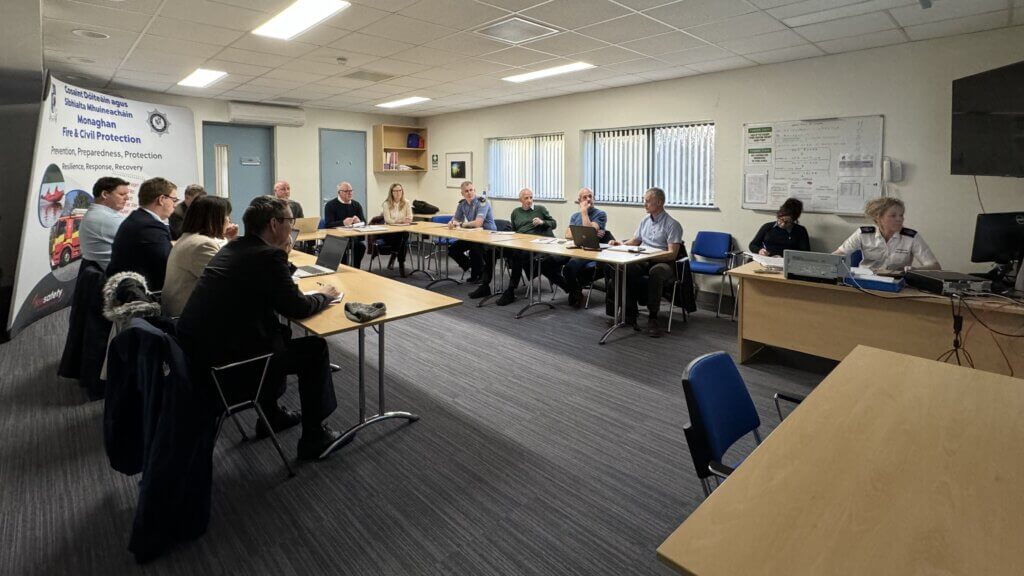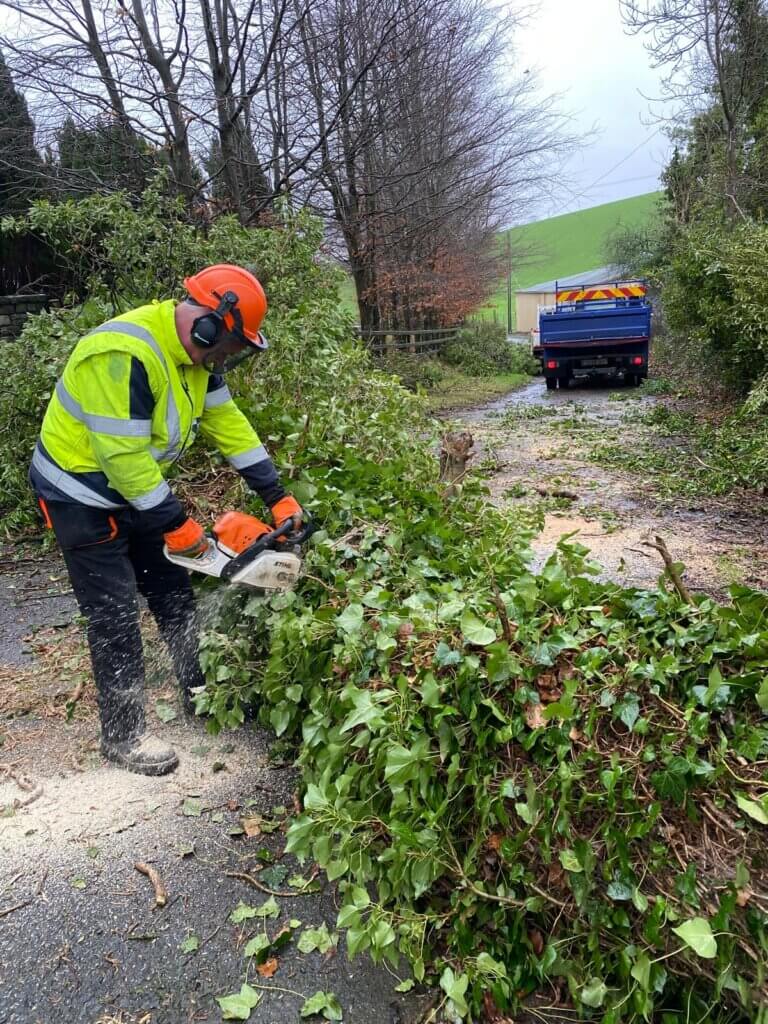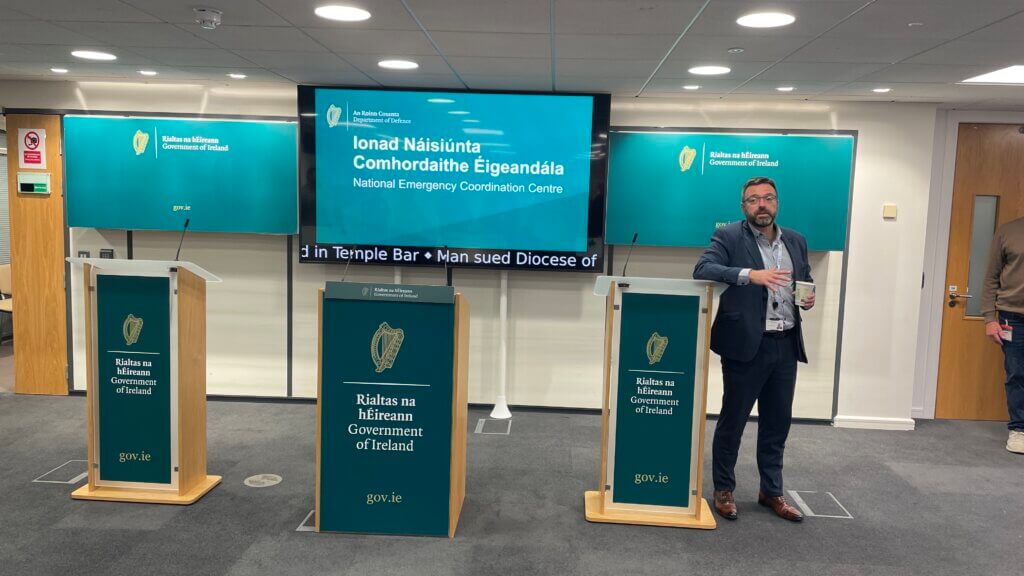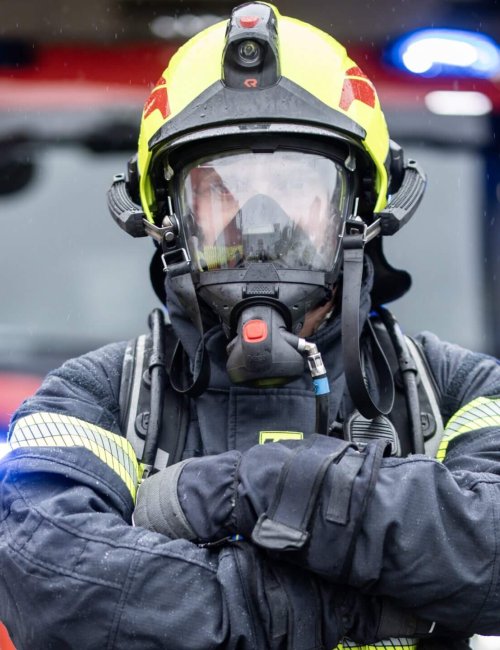Resilient local communities and locally rooted emergency services were the lifeline when Storm Éowyn plunged 820,000 Irish homes into darkness in January 2025.
Extreme weather events are becoming more frequent and severe, and the threat from incidents such as cyberattacks and sabotage has increased due to the worsening security situation in Europe. This new threat landscape led the Danish Emergency Management Agency (Beredskabsstyrelsen) on 15 June 2024 to recommend that citizens in Denmark should be able to manage on their own for three days in the event of a crisis.
But what if the crisis drags on, leaving electricity, water, and heating unavailable for two weeks in the middle of winter?
This scenario became a reality in Ireland in January 2025, when Storm Éowyn toppled trees onto telephone and power lines, plunging the Emerald Isle into darkness.
Dermot Brannigan, Chief Fire Officer in Monaghan County, received briefings from the National Directorate for Fire and Emergency Management (NDFEM) in the days leading up to 24 January, warning that a storm was on its way.
Warnings of this kind are routine on Europe’s western weather front, where the winter of 2023–2024 brought no fewer than 12 named storms. Preparations were therefore already in place, and to anticipate the situations that can arise during severe weather, Ireland routinely stress-tests the country’s communication preparedness.
This is carried out twice a year ahead of the winter and storm seasons by the National Emergency Coordination Group (NECG), based at the National Emergency Coordination Centre (NECC), Ireland’s version of the Danish emergency group, National Operations Staff (NOST).
Devastating Storm Approaching

On 21 January, authorities went out across multiple media channels to warn that a damaging storm was approaching, after Ireland’s meteorological service, Met Éireann, confirmed that hurricane-force gusts would strike Ireland hard.
The NECG convened its first meeting regarding Storm Éowyn on 22 January to address the challenges a hurricane could cause. More than 500 people participated virtually, including representatives from all ministries, government departments, local authorities, and relevant emergency organisations, including Water, Electricity, transportation and broadband utilities.
During the meeting, a national briefing outlined the potential consequences and scope of Storm Éowyn, as well as the risks to life, property, and infrastructure posed by strong winds, high water levels, and heavy rain.
It was concluded that Éowyn was likely to be both damaging and destructive beyond any previous storm, with widespread consequences for the entire country. The government’s focus was therefore on preparing all local communities for the storm, and a press release was issued the same day detailing the expected impact.
At the same time, two subgroups were established within the NECC: one to coordinate all parties involved in protecting critical infrastructure, and another focused on transport and educational institutions, given the risk of nationwide shutdowns.
On 23 January, the NECG held its second meeting, this time bringing all ministries and agencies together in the command centre at the NECC, while over 600 participants joined online. The aim was again to ensure all necessary measures were in place. Following this, a press briefing was held at the government’s crisis communication office, a permanent institution located adjacent to the national coordination centre.
The message to the public was clear: the approaching hurricane would be damaging, destructive, and life-threatening. Unnecessary travel outdoors was strongly discouraged, and due to the high risk of a power grid collapse, citizens were advised to fully charge mobile phones in case of power failure.
A Storm of Unprecedented Scale
The threat from Storm Éowyn was acute, and in County Monaghan, near the border with Northern Ireland, Fire Chief Dermot Brannigan convened the local Crisis Management Team at Monaghan Fire Station on 23 January to organize the local response and develop a robust local crisis plan. And indeed, it would prove necessary.
On the night of 24 January, the storm of the century hit Ireland, with hurricane-force gusts measured at 184.2 km/h (over 51 m/s). Four weather stations along the northern and western coasts recorded wind speeds unprecedented in Ireland.
By morning, the landscape had been transformed. Fallen trees and objects hurled by the storm were everywhere. The electricity network was particularly hard hit, not least because nearly all power transmission in Ireland is carried by overhead lines. Later assessments revealed that 820,000 homes were left without power, and even two weeks after the storm peaked, over 5,000 homes were still without electricity. It took 18 days for the entire country to be fully reconnected.
The national crisis team convened at 9 a.m. on 24 January, while the storm was still ongoing, to assess the damage, regroup, and prioritize the deployment of resources. It was clear that restoring electricity, water, and communications to households, businesses, and more than 100,000 farms – many of which were now in darkness – would require a massive effort.
At the national crisis meeting a small core team gathered in the NECC’s crisis room while participants with remaining local power, telephone, and internet connections joined virtually. The plan was drawn to restore infrastructure as quickly as possible, while continually updating and communicating the national situation.
The scale of the disaster quickly became clear to national authorities in Dublin, which was not severely affected by the storm, as extensive work began in rural areas left without power, water, or contact with the outside world.
This was the situation in County Monaghan, where 20,000 homes were left without electricity indefinitely.
Everyone looked after their own

At Monaghan Fire Station, priorities had to be set among the many tasks awaiting firefighters once it was light and safe to move outdoors, as the storm had left everything in chaos.
-In the emergency services, the greatest impact came from downed power and telephone lines. We prioritized clearing debris and making roads passable and safe, explains Dermot Brannigan, whose team worked tirelessly to remove fallen trees using chainsaws.
It quickly became apparent that the lack of electricity caused problems beyond households being without power. Both the sewage and water treatment systems failed, and for fourteen days, many residents had to venture into the winter cold to use the toilet.
Water also disappeared from taps, and it became clear to Dermot Brannigan and the local crisis team that extraordinary measures were needed. Emergency water tankers were deployed locally to provide residents with drinking water.
Local people were unprepared to handle a situation without electricity, water, and heating for an indefinite period. According to Brannigan, the pressure on households meant that, in the initial phase of the crisis in County Monaghan, human nature kicked in, with everyone’s initial reaction was to look after themselves and immediate family members.
-Cooperation with neighbours was secondary in the initial stages – it was about looking after yourself and self-preservation, he explains.
The fact that all families were affected also impacted the local rescue effort, as many part-time firefighters had their own families to care for before they could assist other citizens – everyone was affected to some degree.
-Some rescuers had to look after their families before going out to help where roofs had been blown off houses. When assessing the damage, we had to decide locally whether it was safe to operate in such extreme conditions – even for rescue workers.
A Powerless Society
Electricity was only fully restored across Ireland on 11 February, 18 days after the storm peaked. In Monaghan County, the rescue effort quickly became about keeping a local community functioning without necessities like power, water, or communication, as mobile networks and the internet were down after the first day.
No communication and no electricity—what do you do?
The answer, according to Dermot Brannigan, came from the local population itself.
-People are incredible—they organized themselves, and we were there to support them. Within one to two days, we were back on track, adapting our response to support residents, he explains.
Eighteen local collection points were established in County Monaghan in the days following the storm, and nationwide, 380 community hubs were activated. Sports clubs and municipal buildings became local meeting points where people could collect water, take showers, charge phones, and enjoy a hot meal. Emergency generators ensured these hubs became beacons of light in the darkness.
-People in the most remote areas managed almost entirely on their own with local hubs, but we helped transport water and other supplies. We also provided advice, but it was mainly networks at association level that engaged their members, supported by the fire service with generators, water, and other resources.
Due to the collapse of both landline and mobile networks, many rural residents were unaware of the centers initially. FM radio quickly became the most important communication channel when all else failed, with local radio stations providing updates on local conditions and official guidance.
Rescue service radios were also heavily affected, necessitating alternative internal communication channels.
-We are now working on how to communicate in such a crisis next time. Not all pagers worked—so how do you summon rescue workers when systems are down? That was a problem, says Dermot Brannigan.
Again, the local communities themselves provided solutions. Neighbors contacted each other, and where possible, local communication was maintained via social platforms. National media were active on radio and television, but the failure of both landlines and mobile services caused significant issues.
-A call center was set up – but nobody could call in. So, the physical hubs were critical, and they will be a permanent part of the setup in the future. People will then know there will be hubs open when they cannot reach authorities or each other.
Evaluations after Storm Éowyn revealed that mobile transmitters lacked backup power, leaving large parts of the population without communication within hours, often with only a car radio functioning. Ireland is now looking to strengthen critical infrastructure, including mobile networks, to prevent a recurrence.
Elderly People Managed on Their Own
The local community hubs provided a lifeline for keeping local society functioning during Éowyn’s severe crisis. A key lesson for the future is that local crisis centres must be ready before a crisis occurs, and everyone must know where to go when all else fails.
-Contact must be made early, and people registered for assistance if problems arise. Politicians must communicate more clearly. Strong communication is essential. Locally, there must be better coordination across all municipal capacities, recommends Dermot Brannigan after the longest operation of his career.
Priorities at Monaghan Fire Station post-Éowyn were clearing roads, restoring power, broadband, street lighting, and repairing damaged buildings, followed by installing emergency generators at strategically important locations without existing backup.
In preparation for the upcoming storm season, County Monaghan has purchased new emergency generators to be ready for the next infrastructure test, minimizing the risk of fallen trees plunging the community into darkness again.
-We have initiated a County Tree Strategy, as many people are opposed to trees and want them removed to prevent road and line damage, he adds.
By 6 February, 5,000 homes across Ireland were still without power – 400 in Dermot Brannigan’s rural Monaghan area. Although more than ten days without electricity seem unimaginable in a modern society, reality proved different.
-We found many preferred to wait for power rather than evacuate. Many choose to stay in their homes without electricity rather than go to a hotel at public expense. Especially older people living alone in rural areas—they can manage on their own.
During the prolonged crisis, the local crisis management group in County Monaghan met at least once daily. This was necessary, as more problems arose each day, highlighting vulnerabilities in prolonged crises.
At the same time, decisive action was evident, with communication challenges within the rescue service often resolved by establishing fixed meeting points to review ongoing operations.
Businesses were part of the local response
With refrigerators out of action and pantries emptied, demand for food and everyday necessities was high within days. Retailers did their best to assist residents.
-Community Centres and businesses made facilities available and switched to cash, as digital payment didn’t work—they were part of the local response. Large companies had plans from the COVID-19 era, so people could work from home where power was available, Dermot Brannigan explains.
Authorities unaffected by the storm supported local communities like County Monaghan by helping remove fallen trees with chainsaws, providing drone-assisted damage assessments, and dispatching water tankers to areas cut off by the blackout.
Disaster Preparedness Must Be Strengthened

In week 42, the Irish government published the report Review of Storm Éowyn, clearly demonstrating the scale of the task facing Irish society – and particularly emergency services – when 820,000 homes were without power, some for 14 days.
The cleanup costs were estimated at €301 million, with County Monaghan calculating €1.1 million for Brannigan’s local operation – more when factoring in infrastructure restoration.
-We were trapped, unable to see what was coming at us, Brannigan told a delegation of 25 Danish Emergency Management (Danske Beredskaber) representatives in September, who visited Dublin to learn about Fire Ireland’s response to Storm Éowyn.
Ireland now believes it has answers for how a modern society can cope for two weeks without electricity and water. The key is to prepare society for what people should and can do when everyday life breaks down.
-Storm Éowyn tested our resilience. Strong collaboration ensured critical functions could be restored quickly. We exposed vulnerabilities in communication and infrastructure, and we are committed to continuously improving both, says Dermot Brannigan.
Recommendations from both the national level and Dermot Brannigan include:
- Continuously updating crisis plans to reflect current realities and threats.
- Expanding personnel and enhancing training for volunteers in emergency services.
- Communicating with citizens via SMS, FM radio, and analogue boards in public areas during crises.
- Implementing an emergency communication system with satellite phones to maintain contact when networks fail.
- Designating and equipping local civil hubs for emergency support.
- Investing in resilient infrastructure and emergency generators and burying overhead power lines.
- Developing a comprehensive emergency plan and protocol for crisis situations.
National Emergency Coordination Group (NECG)
NECG is activated during emergencies with national impact. Public safety and frontline support are the main priorities in the early stages. Task-specific subgroups can be activated to focus on the response quickly. Subgroups activated during Storm Éowyn included:
- Humanitarian aid coordination
- Public transport and education
- Critical infrastructure
- Communication infrastructure
- Emergency communication
These subgroups are activated for all NECG responses during severe weather. If a subgroup is unnecessary, it may be disbanded by agreement at the NECG main meeting.


By Jakob Tilma, Danish Emergency Management (Danske Beredskaber).
This article is based on the Irish government’s evaluation of Storm Éowyn and a presentation to a Danish Emergency Management delegation in September by Dermot Brannigan, Chief Fire Officer, Monaghan County.

